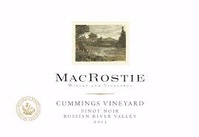MacRostie Winery and Vineyards, Russian River Valley Pinot Noir, Cummings Vineyard 2013 ($56): Not all that long ago, it seems, I approached California Pinot Noir with caution: Although some very fine  wines existed, too many Pinots suffered either from insensitive, manipulative winemaking or from uninspired vineyard sourcing. My, how things have changed!
wines existed, too many Pinots suffered either from insensitive, manipulative winemaking or from uninspired vineyard sourcing. My, how things have changed!
MacRostie Winery’s Pinot Noirs have always landed in the positive camp for me. But even so, California’s — and especially Sonoma County’s — trend toward higher quality Pinot Noir has made those wines even finer.
Consider the basic MacRostie Pinot Noir, currently the 2013 Sonoma Coast Pinot Noir, which sells for $34. Until the 2008 vintage, the wine carried the Carneros AVA and I loved it in many vintages, especially 2004 and 2006. But Steve MacRostie has driven the winery’s vineyard sourcing westward, and the current wine has more finesse and complexity than I recall in the earlier versions. The wine shows a fine line of acidity, cherry and floral notes and persistent length. Almost half of the grapes for the 2013 wine came from Russian River Valley; the balance includes grapes from the Petaluma Gap and Fort Ross-Seaview, acclaimed cool-climate areas for Pinot Noir. Specific vineyards include Steve MacRostie’s own Wildcat Mountain Vineyard in the Petaluma Gap, Goldrock Ridge in the extreme Sonoma Coast near Annapolis, Hellenthal in Fort Ross-Seaview, and Dutton Winkler in Russian River Valley.
For the winery’s Chardonnays as well as its Pinot Noirs, Steve MacRostie works with renowned growers, and winemaker Heidi Bridenhagen produces several single-vineyard wines. The two current single-vineyard Pinot Noirs — 2013 Cummings Vineyard from Russian River Valley and 2013 Manzana Vineyard from Green Valley, both $56 — are terrific. My favorite of the two by a slight margin is the Cummings Vineyard Pinot Noir, from a small property in the Santa Rosa Plains area of Russian River Valley farmed by viticulturalist Charlie Chenoweth. The vineyard is planted with three Dijon clones of Pinot Noir: 667, 777 and 115.
The Cummings Vineyard Pinot Noir has darker fruit notes than the less expensive Sonoma Coast wine, particularly dark Bing cherry. Its flavors are vibrantly fruity with notes of spice and a woodsy hint. Although it is full in body and viscous in texture, the wine is not dense but tensile, as if it might sing in your mouth. The wine’s tannin is supple and unobtrusive, lending firmness but not hardness.
The 2013 Manzana Vineyard Pinot Noir is firmer, darker, richer and tighter. It is also less expressive and more enigmatic. I do perceive lovely blackberry fruit in the aroma and flavor, but in general the wine is reserved at this point and seems to be in hiding. The quality elements are there: concentration, substance that is uncommon in Pinot Noir, an admirable acid-tannin balance. But this wine needs time to reveal itself. Production of the Manzana is half that of the Cummings, just four barrels — 95 cases — compared to 184 cases of the Cummings.
The 2013 Cummings Vineyard Pinot Noir itself can likely age nicely, but it doesn’t cry for age as the Manzana Vineyard Pinot Noir does. Enjoy it now and for the next five years or so, by my estimate.
92 Points
